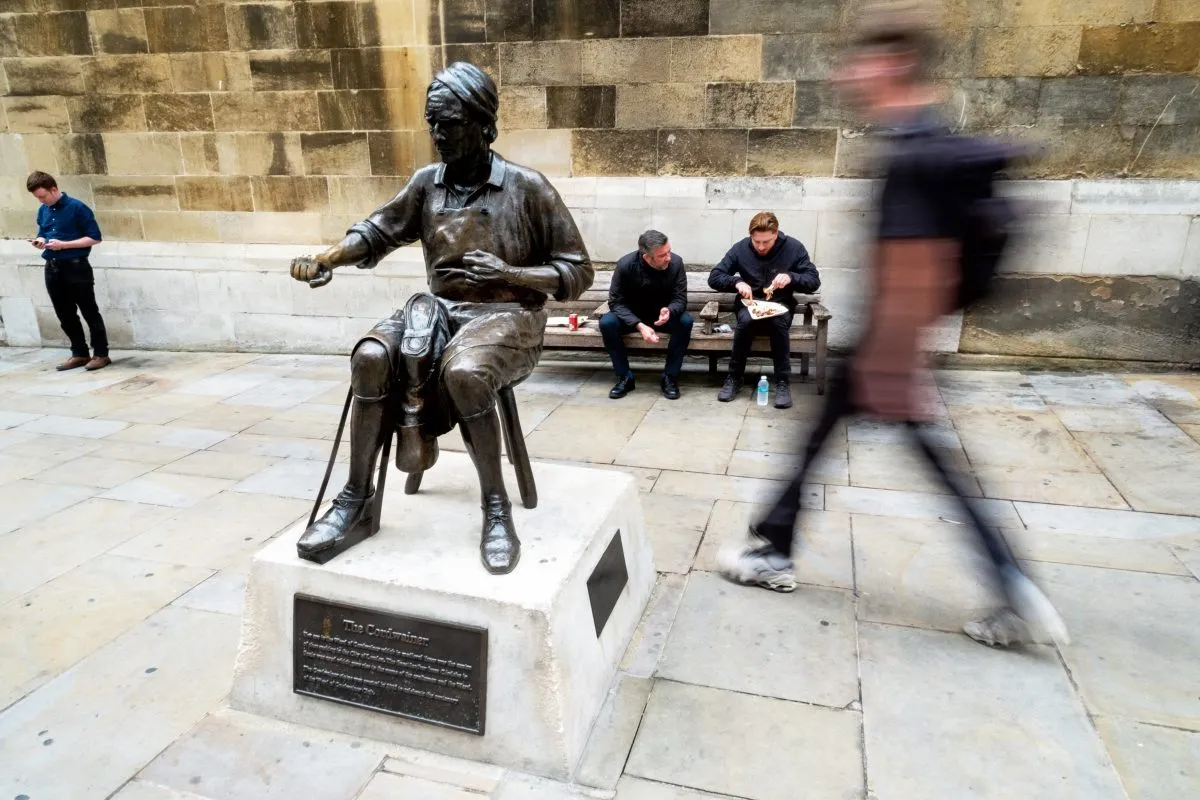By Anna Moloney Scott Barbour
Forget stocks and shares, the Square Mile has an illustrious history full of shoes that deserves celebrating, writes Anna Moloney
Patrick Cox was the it shoe designer for 1990s fashionistas. When Victoria Beckham got her first paycheck from the Spice Girls, it was to his London shop she ran, queueing up outside on a Saturday afternoon with her sister to nab a pair of his iconic white slingbacks – aptly called the Wannabes. But as his star rose, so did it fall, with his eponymous brand – and his mental health – collapsing in the mid-noughties. Since then, with the help of psychedelic therapy, he’s relocated to Ibiza, where he now runs his new shoe brand Doors of Perception, a “consciousness-raising” clothing line, “ethically sourced, sustainably produced, and embroidered with love right here on Ibiza”.
So to find him among the lah di da corridors of Saddlers’ Hall, a stately building stood in the heart of London’s financial district, earlier this month was, it’s fair to say, a little off-brand.
But Cox, like many London shoemakers, owes much of his legacy to the Square Mile, or, more specifically, the Cordwainers, one of the oldest livery companies in the City whose legacy lives on with surprising vitality and glamour today – counting the likes not only of Cox, but of Jimmy Choo, Sophia Webster and Stuart Weitzman among its ranks. Not names you’d necessarily associate with the Square Mile. “Wow, the Cordwainers are older than my country,” American Weitzman exclaimed when becoming a liveryman.
Indeed, just down Watling Street, in the heart of the financial district, is a statue – not of a banker, but a shoemaker. Cast in bronze, The Cordwainer shows the craftsman hard at work, brow furrowed and arms strained, as he makes a pair of leather boots. Beneath his stool, the inscription proudly proclaims: You are in the Ward of Cordwainer.
It happens to be nestled right where the punters of The Wren Tavern gather, amongst whom almost the entirety of City AM’s newsroom counts itself on a Thursday night, yet I’d never noticed it before Penny Graham, clerk of the Worshipful Company of Cordwainers, told me about it.
Dating back to 1272, the Cordwainers existed primarily to perform a regulatory function, giving its stamp of approval to quality footwear in London, while also ensuring the legacy of the craft through training apprentices and supporting its members and their families through ill health or widowhood. And of course, style was important too: the defining feature of all liveries was literal – a fabulous outfit you could wear to show off the status of your craftsmanship.
Almost 800 years on, albeit with its regulatory function shed, the Cordwainers – and much of the regalia – survives today as a champion of the shoe industry, not least through its support for shoemaking schools such as the London College of Fashion’s, previously known as the Cordwainers’ Technical College where Cox himself studied, and for which the Worshipful Company now throws an annual prizegiving bash to celebrate the next generation of Cordwainers. And it’s this, the Cordwainers’ annual Footwear Award, that lured Cox, clad in a suitably irreverent open-toe pair of his own Doors of Perception sandals (a little like Birkenstocks but with gold eyes for buckles), back to the City this month.
The annual ceremony gives prizes to students to allow them to pursue the craft, while also allowing them to network with legends of the industry and – of course – show off their shoes. “Don’t even try,” was Graham’s sage dress code advice ahead of the ceremony. At this year’s awards, it was Jimmy Choo being venerated as the recipient of the company’s Award for Excellence, collected by his daughter, and I met one woman in reception (a friend of Choo’s) who was lucky enough to boast a wardrobe of 43 pairs, many bespoke.
Cox may have admitted that Cordwainers College, where the shoe designer says he spent far more time partying than studying, was “not the happiest time of [his] life”, but he knows it is an important part of the legacy of shoemakers.
Having mellowed from his time in Ibiza, Cox says he came to the ceremony as a way to give back to his community – along with some sage advice. “Really consider if you want to use your name – losing your name means more than losing your company,” he cautioned during his speech, along with what felt like a salient tip to “never sign a personal guarantee”.
For the next generation of shoemakers and shoe designers, such caution will be even more important, with shoemaking now on the heritage craft endangered list. With it now much cheaper to manufacture on mass and abroad, it doesn’t take too much deduction to figure out why, but the Cordwainers are adamant the craft is important.
Asked why we should even bother caring about protecting it, Graham is existential: “If we lose these crafts, we will never get them back because you lose the ability to teach them. Perhaps they’re never going to be huge, but it’s a very, very beautiful skill.” Deborah Carre, the bespoke shoemaker behind Oxo Tower-headquartered Carreducker, is also emphatic on the importance of the skill for the whole industry. “It’s a living heritage… the craft of hand shoemaking informs the processes within manufacturing… it’s not the preservation of the craft, it is an evolution of the craft”.
At the Cordwainers Awards, where shoes on exhibit ranged from horned trainers to collapsible heels to two-footed shoes, such evolution was certainly on display.
